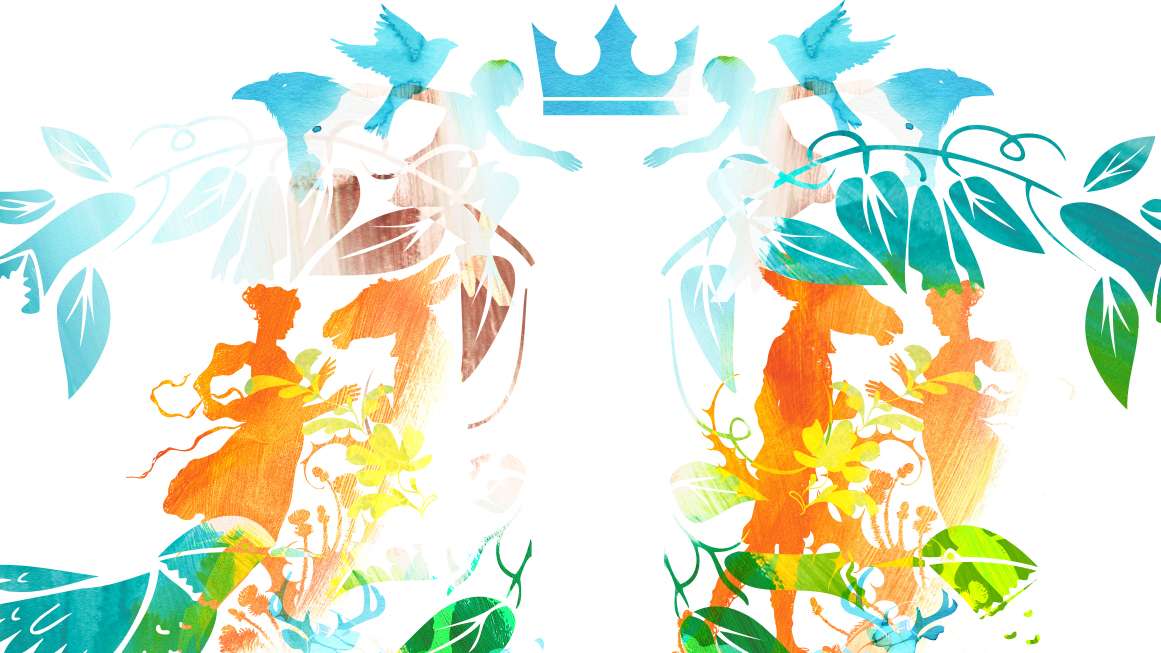By Sarah Skwire
Copyright reason

The formula is simple: Combine the best-loved traits of J.R.R. Tolkien’s high fantasy and of modern romance novels, make the characters’ sex lives explicit and very detailed, and include a lot of descriptions of beautiful gowns and luxurious bathtubs. Put a lushly illustrated cover on the front. Back it up with authors who have very active social media presences, and get the ever-growing world of fans on BookTok (the book-focused corner of TikTok) and Goodreads to read and review. Call it romantasy or faerie smut—the new genre is everywhere.
Of course, it’s not really a new genre. I say that not because romantasy combines strands of several previously existing genres—romance, fantasy, and (often) horror. A new kind of pastiche still counts as something new. But literature that combines fantasy and sex is at least as old as the 12th century lais of Marie de France. In one such lai, Lanval, a knight in King Arthur’s court is wooed and seduced by a beautiful barely clad fairy maiden he meets in an ornate golden tent in a meadow. Yonec tells of an unhappily married young woman whose lover transforms himself into a bird to fly in her window. Bisclavret is the story of a werewolf baron who is betrayed by his human wife. Shakespeare’s A Midsummer Night’s Dream shows the audience Titania, the fairy queen, and the very human weaver Nick Bottom in love and in bed. And Christina Rossetti’s poem Goblin Market is a Victorian fever dream about the pleasures and consequences of sucking on goblin fruit.
The world of faerie is the world of the other, the mysterious, the forbidden. And all of that is sexy and dangerous in ways that have appealed to humans for a very long time. It’s really only with the rise of sharp genre distinctions—evidenced by bookstore section headings that cloister romance, fantasy, and science fiction from one another—that this kind of erotic, adventurous, magical melange became uncategorizable and thus unmarketable. (I’m inclined to think that the way Amazon and other online bookstores break down the distinction between genres and sections of a traditional bookstore might be a small technical driver for the return of romantasy.)
Technical questions aside, there may be something uniquely 2025 about the way romantasy has come roaring back to life. The overturning of Roe v. Wade and the rise of the hard right have put questions of women’s autonomy and power at the center of American political and cultural discussions. Though it may surprise those who haven’t read much in the genre, romantasy puts those questions right in the center of its texts.
Transformation
The classic plotline of a generic romantasy novel runs something like this: A young woman who is overlooked and undervalued in her normal life enters a different, magical world where she is a being of extraordinary abilities. She attracts a passionate and highly desirable partner who introduces her to sexual heights she has never before experienced while also drawing her into political and military intrigues that allow her to utilize her newly valuable abilities. Over the course of the story, there will be heartbreak and separation, but an eventual happily ever after is nearly certain.
There is nothing revolutionary about the standard romantasy plotline. Its basic steps align precisely with Joseph Campbell’s idea of the “hero’s journey,” marked by separation from a familiar environment, initiation into a new one, and a return to the old world once the hero has been transformed by experience. Swap in hungry hobbits for horny heroines and you have Tolkien. Subtract the magic and you have the plot of Jane Eyre. Subtract the sex and you have The Chronicles of Narnia. But fantasy novels that focus on an adult female lead character and her journey and desires, while far more common than they were when I began reading them in the ’70s and ’80s, still feel a bit radical, just by virtue of taking a woman’s point of view.
It is the genre’s focus on transformation, stepping into power, and recognition that seems to me to be its most compelling aspect for readers right now. While traditional fairy tales often focus on a magical transformation that comes from outside the main character—think of Cinderella’s gown and coach, or the frog who is changed into a prince—romantasy often deals with a character whose strong sense of self remains unchanged, but whose importance, skills, and even physical beauty change in value as she enters a new world.
This moment where the undervalued becomes valued may be the defining dream of fiction produced for a largely female audience. The best-selling series A Court of Thorns and Roses features a protagonist, Feyre, who begins the series as a neglected and overworked middle sister, hunting game to feed her impoverished and unappreciative family. By the end of the first three books in the series, she is the high lady of the Night Court. She has used her hunting skills to vanquish terrifying monsters, her intellect to outsmart several enemies, and a physical attractiveness that no one has ever noticed before to win the love of two faerie high lords. She has also died and been resurrected, brought her family into the faerie world with her, fought in several military campaigns, and (in a classic fairy-tale trope) seen her small kindnesses to magical creatures repaid with assistance at crucial moments. She says of herself, by the end of the second installment of the series, “No one was my master—but I might be master of everything, if I wished. If I dared.”
Rebecca Yarros’ The Empyrean series presents us with a heroine with a similar trajectory. Violet Sorrengail, who has studied her whole life to be a scribe, is thrust by her mother into a military college that trains cadets to partner with dragons for battle. Suffering from a mysterious ailment that causes her constant pain and frequent joint dislocations (based on the author’s own experience with Ehlers-Danlos syndrome), Violet seems like the least likely survivor of the war college’s vicious training. Not only does she survive, but she also bonds with the rarest and most powerful type of dragon. And then she bonds with a second dragon, of a type no one has ever bonded with before, and is told, “I waited six hundred and fifty years to hatch. Waited until your eighteenth summer, when I heard our elders talk about the weakling daughter of their general, the girl forecasted to become the head of the scribes, and I knew. You would have the mind of a scribe and the heart of a rider. You would be mine.” Violet develops a series of increasingly impressive magical powers, attracts the love of a (nearly equally powered) fellow soldier who turns out to be a duke, restores the protective wards around her country, battles vicious enemies, and becomes an impressive military strategist, often using her formerly undervalued scribal skills to find creative and unexpected solutions to political and military problems.
That both these series place their heroines into positions where they must be politically and militarily savvy is, I think, no accident. Readers of this fiction grew up on epic fantasy novels with complex world-building and political wrangling, and they want the same attention to detail from romantasy. This means that romantasy heroines must, in general, be prepared to tangle with warring fairy courts, espionage, maintaining magical defenses and supply lines for troops, and diplomacy in cultures and languages that are wildly alien to their own. Romantasy heroines have personal problems to solve that matter intensely to them, but they are equally involved in the world-altering problems that surround them. Just as in the real world, the personal and the political both demand the heroine’s attention and talents. In the world of romantasy, it is possible to triumph simultaneously at both. Romantasy heroines can have it all and a dragon, too.
As I read through both series and a selection of other romantasy novels while researching for this article, I kept thinking of economist Claudia Goldin and her lecture, “The Quiet Revolution That Transformed Women’s Employment, Education, and Family.” Goldin observes that women’s gradual move into the labor force “was a change from agents who work because they and their families ‘need the money’ to those who are employed, at least in part, because occupation and employment define one’s fundamental identity and societal worth.”
In romantasy, the work of the hero and heroine often intertwines as they try to save the world, protect their communities, discover hidden knowledge, or generally engage in a quest. Importantly, it gives them a project that they are working on together. Work has always played an underappreciated role in romantic fiction. But as contemporary politics mean that male and female spheres of interest and influence feel increasingly separate, the appeal of reading about that kind of shared project only increases. Istvhan, the berserker knight, and Clara, the nun and werebear, from T. Kingfisher’s Paladin’s Strength have unique capacities for destruction that often go unappreciated by the rest of the world. As a team, they are a well-matched delight, wreaking mayhem when necessary and fighting together with élan.
“Protect the nun!” roared Istvhan, yanking his sword free. “Protect your own damn self!” Clara roared back.
Romantasy heroines are not sidelined in politics or in battle. They are equal, even superior partners.
It’s not all violence, either. There is an entire subgenre of romantasy dedicated to heroines who are busy building small businesses. Legends and Lattes by Travis Baldree, for example, tells the story of an orc who is retired from mercenary work and just wants to open a coffee shop. A sequel explores the same orc’s stint of working in a bookshop while recuperating from battle injuries. That novel’s best-known tagline, “Things don’t have to stay what they started out as,” is a fairly good shorthand for Goldin’s quiet revolution.
Even now that we are well-established in the labor force, women obviously still find stories about women finding identity and worth through occupation and employment enormously compelling. Women who long to achieve that kind of satisfaction are inspired by reading stories of others doing the same. It is this longing that makes stories of entrepreneurs so important and popular. It is this longing that drives the success of dubious multilevel marketing companies that persuade aspiring girlbosses that they can become millionaires by selling leggings. And it is this longing that fuels romantasy, where the jobs may be slightly less plausible but the quest for identity and desire for worth are the same.
That same longing for recognition fuels the romantic and erotic relationships in romantasy. While traditional fantasy may sometimes contain romantic elements, romantasy treats the romantic and erotic desires of its characters as equally important to their quest to resolve the magical and political tumult that surrounds them. A friend of mine who is a devoted romantasy fan noted that the love interests of these books are often mysterious and emotionally remote “damaged” characters who open up to only one person—the previously overlooked heroine. His attention, given to no one else, is another indication of her unique value. And his ability to see how remarkable she is marks him out as unusual and worthy of love as well.
The intense romantic bonds between the heroes and heroines of romantasy are often depicted not just in emotional terms, but also as part of their magic. Frequently, they are able to read one another’s minds, telepathically communicate over long distances, and strengthen one another’s individual magical gifts. It is not far from Cathy’s insistence in Wuthering Heights that, “I am Heathcliff! He’s always, always in my mind: not as a pleasure, any more than I am always a pleasure to myself, but as my own being. So don’t talk of our separation again: it is impracticable.” The subgenre of romantasy that focuses on shape-shifters like werewolves and other human/beast hybrids makes much of a mysticized version of animal pair-bonding when it explores its characters’ romantic connections. There can be no more intimate connection imaginable than to have a partner who is destined to you by both fate and pheromones, who can read your mind, and who can communicate with you when no one else can.
The erotic scenes between these characters are often extremely explicit, and they often explore kinky and alternative sexualities. Romantasy is a genre where erotic and emotional combinations of all genders, species, and magical races are embraced with enthusiasm and delight. Many discussions of the genre express feminist qualms over the way that the male heroes are supportive of their high-powered partners outside the bedroom, but inclined to dominate them in bed. It’s a reasonable point. But these books revel in the sexiness of explicit consent. That erotic dynamic of exploring and experimenting with the taboo aligns with the way the genre as a whole plays with questions of what it means to have power and to be powerless. In the same way romantasy heroines shift from powerless to powerful as they enter the world of magic, their erotic life enables them, and the reader, to explore those changes in a physical context.
Those explorations can be very dark indeed. The vampire romances that seemed so edgy in Buffy the Vampire Slayer and Twilight are weak tea for romantasy readers. Laura Thalassa’s The Four Horsemen series takes the incarnations of Pestilence, War, Famine, and Death as its romantic heroes. Kingdom of the Wicked has a prince of hell as the romantic lead. The darker the hero, the more likely one is to run into the recurring romantasy trope of a woman who can take endless damage, often at the hands of a sexual partner, and bounce back physically and emotionally. It will be a long time before I recover from reading Lindsay Straube’s Kiss of the Basilisk, where a woman is so violently mated by her shape-shifting partner that her pelvis breaks. A recent conversation with some horror writers, however, makes me wonder whether writers who eroticize this kind of violence are using it as a way to cope with increasingly threatening sexual politics. Getting the monster to fall in love with you is one way to solve the problem of a culture that sees you as prey.
Conversation
Read too much romantasy in too little time, and all the dark faerie lords and maladroit human women with special gifts begin to melt together. You’ll begin to notice the sometimes awkward juxtaposition of Instagram-inspired fantasies of a magical good life marked by glamorous gowns, palaces, jewels—all those bathtubs!—and the rugged woman warrior tropes borrowed from dystopian fiction. These books are fantasies of infinite luxury and of rugged survival against all odds at the same time. Part of the appeal, I suspect, is that these heroines are simultaneously ready for a Vogue cover shoot and drenched in the blood of their enemies.
Like other kinds of romance, romantasy is escapist fiction, and that’s always easy to mock. But the interesting thing about romantasy is that its readers know that. Their TikTok videos and commentary on Goodreads and elsewhere make it clear that the readers love these books—often passionately—but they also read them with a critical mindset and very little patience for authors they don’t respect. Yarros, in particular, has come under fire online for a ludicrously overpowered heroine and a plot that, readers argue, has been stitched together from elements of previous successful series.
But that sharply critical eye doesn’t prevent romantasy readers from defending the genre against all outside detractors. Those who write articles with titles like “The Porn-Brained Women of Monster Smut” that criticize the “spice level” of romantasy or moralize about it as just “pornography for women” are likely to be reminded that the multibillion-dollar pornography industry caters almost exclusively to men. Readers will point out that the romantasy industry’s estimated value of $610 million is nothing in comparison. Is it targeted because it’s largely written by women, for women, with women’s desires at the forefront? Surely, even the most explicit faerie sex scenes one can imagine have analogs in porn films or in the fantasy novels of George R.R. Martin. I was pointed to the pelvis-shattering violence of Kiss of the Basilisk, in fact, because it had inspired such a vigorous online discussion on exactly these lines.
Readers don’t just consume these books. They debate and discuss them, trace the fairy tales and myths that lie behind them, speculate about future series installments, and put that discussion up online. That community is at least as important to the readers as the books are. Readers have countless stories of making friends in online chats and in the aisles of bookstores as they find others who are browsing the same sections. And the upcoming release of a romantasy novel that began as a darkly explicit work of Harry Potter fan fiction reminds readers that their favorite genre belongs to its fans in a way that most other genres do not.
Popular culture—art, music, television, film, and yes, romantasy—can tell us a lot about what we value enough to spend time and money on. It can tell us even more about our wishful thinking. Mysterious magical beings will always be sexy. But right now, romantasy might be telling us how much we wish for a world where the things that make us weird turn out to be the things that make us special and lovable. And maybe also for a dragon.



